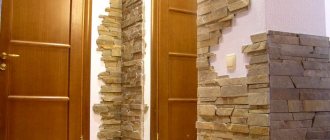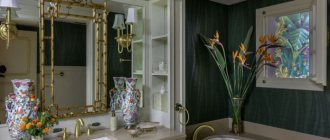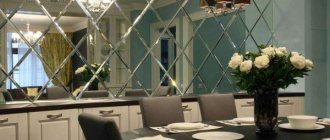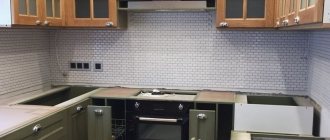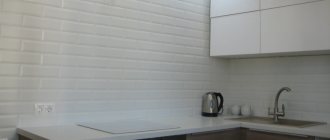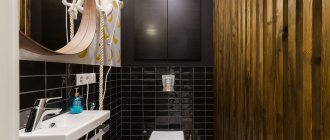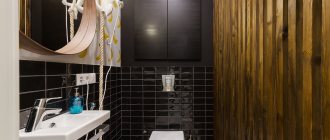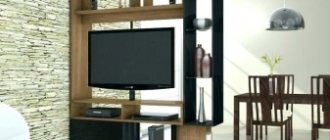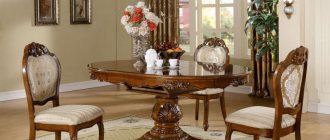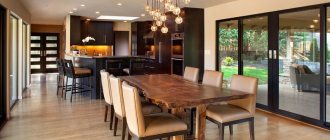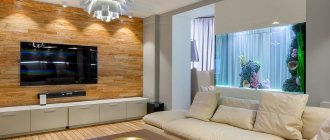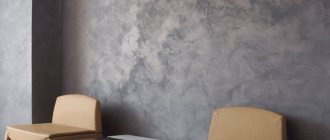Traditional types of cladding, such as paper wallpaper and painting, are less interesting than decorative plaster in the interior, with which it is easy to create an exclusive design for any room. It all depends on the overall design concept, the matching of the base and the surface to be processed. The choice is not easy, so it is important to have an idea of the main varieties, features and capabilities of the most popular dry mixtures and ready-made formulations. Depending on the functionality of the room and the desired texture, a natural or synthetic composition is selected.
Plaster can be completely different
An example of an excellent combination of design with decorative plaster on the wall
Blue walls will make the room brighter and fresher
Pros and cons of interior decoration
Several advantages and disadvantages of this finish.
| pros | Minuses |
| It has an aesthetically attractive appearance and high performance characteristics. | Does not tolerate serious mechanical stress. |
| Goes well with other finishing materials. | |
| Resistant to temperature changes, sunlight and other negative factors. | It has a fairly high price. |
| Perfectly hides unevenness and defects present on the surface. | Some types of coating are not easy to maintain. |
| Has a long service life. | |
| Eco-friendly and vapor permeable. | Decoration requires a large consumption of this material. |
| It has many colors and textures and a huge variety of application methods. |
Positive traits
Design specialists, builders and finishing specialists prefer plaster for various reasons:
- the material may be applied to the surface of walls without prior leveling and processing. All that is necessary is to ensure reliable adhesion of the plaster layer to the wall. To do this, it is enough to cover the working area with a primer;
- the composition of the plaster is viscous, which makes it easy to seal the surfaces of complex shapes - columns, niches, plasterboard structures, semicircular areas;
- The mixture can be colored in any color shade. This helps to decorate the room according to the chosen project;
- There are enough types of plaster material to choose the required option;
- with the help of a protective coating or special components in the mixture, it is possible to ensure long-term preservation of the original appearance, colors, texture and prevent abrasion; As the coating dries, no joints or seams are formed, creating the impression of a solid surface.
The secret is that the plaster is applied gradually, the master does not leave it time to dry and take non-standard shapes.
Another advantage of decorative plaster used in the living room is its high artistic aesthetics, which is difficult to achieve using other finishing materials.
Unfortunately, some types of decorative plaster coating are highly expensive, and the work involved in applying it is also expensive.
.Certain types of plaster require preliminary preparation of the surface or are applied only to ceilings.
Types of decorative plaster for interior decoration
There are several main types.
Venetian
see also
Photo of Venetian plaster
Venetian has a very beautiful complex shade and perfectly imitates noble natural stones. Thanks to such genuine depth and uniqueness of the pattern, the decor takes on a solemn and amazing appearance.
Structural
It contains solid particles that create a clear pattern and give the plane depth, volume and roughness. The structure and severity of the pattern depends on the size of the particles in the composition.
Textured
With the help of such a decorative coating, various imitations of textures are created, for example, it can be natural stone, thin-layer sand concrete, porcelain stoneware or sawn wood.
The photo shows decorative textured plaster on the walls in the interior of a modern kitchen.
Liquid wallpaper (Japanese plaster)
Another commonly used decorative plaster is Japanese plaster. It creates a clear structure on the wall that contrasts with the smooth finish. This product perfectly masks wall unevenness, improves its heat and sound insulation, and is also fire resistant. It can be given many fancy shades.
In the case of decorative Japanese plaster, the price may depend, among other things, on how expressive the texture is.
It is worth remembering that each plaster also requires preliminary priming of the base. In some cases, especially when it comes to stucco, the work must be done by experienced professionals.
Application options
Two ways to use decorative material.
Walls
With the help of such wall decoration, you can give the room special originality and uniqueness, as well as bring any design ideas to life.
Ceiling
This material has excellent plasticity, so with its help you can not only effectively decorate the ceiling or create various reliefs on it, but also hide cracks and minor irregularities in the ceiling plane.
The photo shows a classic bedroom with a ceiling decorated with sand-colored plaster.
Thanks to the ability to create any shape and color on the ceiling, such a coating will look beautiful and harmonious in any interior.
Finishing of stoves and fireplaces
Decorative plaster for decorating stoves or fireplaces must first of all be resistant to high temperatures, heating, rapid cooling and have protective properties.
Kitchen apron
Exceptionally durable, heat-resistant and odor-resistant plaster is a rational option for decorating a kitchen backsplash and creating a stylish and individual design.
Arch
With the help of this magnificent decorative material, which has countless options and is suitable for almost any style direction, it is possible to creatively approach the design of such an architectural element as an arch and turn it into a truly unique interior masterpiece.
Features of use in a modern interior
Decorating the living room
The purpose of the main room in the house is to create a conducive atmosphere for communication. When working on its interior, remember that the largest surface that requires finishing is the walls. Without requiring separate protection from temperature changes or excessive humidity (as in a bathroom/shower or kitchen), without increased requirements for wear resistance (as in an entrance hall/corridor), the decoration of living room walls can be very elegant and have no restrictions in choice.
To prefer a smooth finish (“Venetian”) or embossed – the choice is yours. The criterion is compliance with style and design intent.
A decorative plaster panel on the main wall of the room will give the living room a special uniqueness. Despite the labor, time and energy consumption, such a design element cannot be replicated exactly anywhere else. The uniqueness of the living room decoration is guaranteed.
Stages of creating a relief panel
Surface priming; Formation of the background; Drawing a sketch; Layer-by-layer extension of a three-dimensional pattern (using spatulas, palette knives, brushes, etc.); Smoothing sharp reliefs and carefully sanding them; Drawing coloring and development; Glazing followed by accentuated drawing of light areas; Final priming and (if necessary) varnishing.
The masterpiece of wall painting is ready.
Use in bedroom interior
Since a person is not particularly protected during rest and sleep, the main criterion for choosing wall decor in the bedroom is:
- environmental friendliness;
- safety;
- color appropriateness;
- texture compatibility with the interior.
A room designed to evoke peace and tranquility can be finished with all materials, taking into account the above requirements.
Wall decoration in bathrooms
When choosing an option for wall finishing in the most humid rooms, the main selection criterion is the moisture resistance of the decorative plaster and its vapor permeability. Less attention should be paid to porous, embossed surfaces, and absolute preference should be given to walls coated with water-repellent compounds:
- silicate;
- silicone;
- “Venetian” (having a mineral base, this mixture is equipped with a wax film as a protective layer).
Moisture-resistant surfaces have a unique technology for applying decorative mixtures:
- Multiple pre-priming;
- Special careful grouting-iron plating;
- Drying of the plaster for 3 days.
In addition to hassle-free care, the ability to tint these mixtures (or paint them in various shades) makes them suitable for any stylistic and design conditions. The main condition is to resist moisture in the form of water and evaporation.
Decorating kitchen walls
In addition to high humidity, the decor of the kitchen room must have good resistance to temperature changes. Heat resistance and fire resistance are additional requirements for the ability to repel moisture in any form. Otherwise, there are no restrictions: “Venetian”, decorative panels, structural and textured options - everything is possible for modern kitchen design in a variety of styles from antique to high-tech.
What colors are there?
The color scheme for the room is a very important point in the design of the apartment.
White
Snow-white plaster allows you not only to create a very elegant and graceful decor, but also to give the space additional volume, spaciousness, lightness and weightlessness.
The photo shows the walls in the hallway decorated with white plaster.
Grey
A deep and attractively beautiful gray shade gives the room the right interior background and forms a discreet, inconspicuous, smoky and multifaceted design.
Black
It is a classic and extremely strong color that, when used correctly, can give a room a sophisticated and modern look and turn it into a comfortable, elegantly decorated space.
Red
The spectacular red finish creates an original and daring design that always looks impressive and attracts all attention.
Green
The many faces of green can come in many shades, such as new foliage, dark pine needles, mint ice cream, fresh greens or jewel. Each of them carries a certain palette of emotions and impressions, and in its own way affects the image of the room.
Violet
This color looks prestigious and elegant. Purple is able to fill an ordinary interior with special elegance and luxury.
The photo shows a bedroom with walls decorated with purple decorative coating.
Beige
Calm and neutral beige is a permanent classic in interior design. With the help of this color it is possible to bring a special style and harmony into the environment.
Brown
Noble and expensive brown shades, such as terracotta, cinnamon, bourbon or copper, have a natural and very deep appearance, due to which the space is filled with warmth and coziness.
Yellow
It evokes associations with the sun, adding joy and special energy to the atmosphere. Decorative yellow plaster is considered a rather original and modern decoration option.
The photo shows a children's room with decorative yellow plaster on the wall.
Blue
Depending on the intensity of the shade, blue can create a luxurious, intriguing and relaxing atmosphere in a room and set a certain mood for it.
Gold
Thanks to the extraordinary attraction, external gloss and internal warmth emanating from the golden hue, it allows you to warm up and significantly transform the space.
The photo shows a classic bathroom with golden-colored plaster on the walls.
Silver
The slightly iridescent and shimmering silver color is a very effective, bright and unusual design option when creating a truly original design.
What to consider when choosing the shade of plaster
The color of the walls should not only fit into the overall style of the room, but also have a positive effect on the mood and state of mind of residents and visitors. Different colors can evoke certain sensations, for example:
- active shades have a stimulating effect, set the mood for positivity, but at the same time they can cause anxiety and restlessness. These include rich reds and oranges, yellows;
- passive cool colors have the opposite effect. Improves performance, relaxes, calms. In rare cases, they cause sadness and melancholy. Passive shades include blue, violet, green, cyan;
- White is considered neutral. The interiors, decorated in predominantly white colors, are filled with air, seem more spacious, but somewhat cold.
We advise you to study - Antique and modern Greek style in the interior of an apartment or house
Black color absorbs light and is not suitable for small rooms. Goes well with all shades. Can be accentuating if light colors predominate. Black color is considered warm and gives a positive mood, although in some cases it causes melancholy and depression.
Black decorative plaster accents the wall behind the bed
When choosing interior design and colors, it is important to consider not only the dimensions of the room, but also the lighting. Decorative plasters tend to reflect light at different angles, shimmer, and look different from different angles
Shiny plasters are smooth and reflect light in one direction. They appear bright from one viewing angle, darker from the opposite.
Textured plaster with bronze glazeGolden decorative plaster
Matte plasters are rough, finely porous. Reflect light in different directions. The hue appears rich from any viewing angle.
Plaster “marble velvet”, matteTextured matte plaster
Glossy surfaces - with weak reflections. The play of shades is interesting from different viewing angles. The glossy effect is more pronounced if the wall is illuminated by separate lamps.
Gloss finishGloss on glossy Venetian plaster
Photos of design and effects of decorative plaster
Due to certain design and effects, you can create a unique interior and add luxury, style and good taste to it.
Under the stone
Thanks to the imitation of a surface made of stone, the room takes on a more noble and monumental appearance and becomes much more comfortable and functional.
The photo shows a living room and walls with a decorative coating that imitates stonework.
Under the tree
Decorative design that reproduces natural material, in the form of tree bark, boards, cross-cuts or other wood patterns, has a natural appearance and is practically no different from real wood.
Fabric imitation (velvet, silk)
This imitation of fabric texture looks absolutely exclusive and allows you to create an elegant, deep, unique design filled with comfort and warmth.
Under the skin
Decorative finishing with the effect of reptile skin, for example, snake, crocodile or other leather imitations, is a rather atypical and slightly extravagant interior solution. This design has a unique and exotic look, which allows you to create a very elegant and sophisticated environment in the room.
Pearl
With the help of subtle pearl shine and gentle tints, it is possible to create brilliant glossy accents in the room and give it solemnity and a little mystery.
World map (islands)
A geographical image with clearly marked continents, islands and other characteristic relief will be a wonderful decoration for almost any room.
Two-color
White-gray, black-white, beige-brown coating or plaster with a combination of other color pigments, such as pink and gray, blue and white and others, allows you to achieve the desired effect in the space and give it a special uniqueness.
Antique
Despite the rough, slightly shabby appearance, which is created using a special technique for applying patina, such decorative finishing in the interior looks very dignified, allows you to recreate the atmosphere of the past and give completeness and completeness to certain style directions.
Combination with decorative stone
It is considered a very good and successful combination, characterized by strength, durability and noble appearance.
Varieties by composition
Floral patterns, ceiling stucco, antique stonework, Venetian, large waves - all this and much more can be created from textured plaster.
Decorative plaster can radically transform a home
The material goes on sale not only in white, but also in any other color, in dissolved form or in the form of dry mixtures. Each type has its own composition, preservatives, and fillers. The appearance of surfaces depends on them.
The structural nature of the coating makes it possible to create different patterns and effects. It doesn’t matter whether it’s a ceiling or a wall, a bathroom or a kitchen, a living room or a bedroom, a nursery or a hallway. Color or combinations thereof, texture or pattern are the exclusive prerogative of the master who works with the mixture. The main thing is that everything is combined with the style, and does not look pretentious and provocative. Based on their composition, the following types of textured plaster are distinguished:
Mineral
Mineral - most often used in the kitchen and bathroom
It is based on cement and is sold in powder form. Endowed with excellent resistance to moisture, suitable for any surface. Can be used in the kitchen and bathroom.
Silicone
Silicone - easy to lay on any surface
This is a ready-to-use mixture and does not need to be diluted. fits well and easily on absolutely any surface, be it wallpaper under plaster, old uneven walls or brick. It has good moisture resistance, suitable for corridors, halls, bathrooms or kitchens. It can be used even on unprepared surfaces.
Acrylic
Acrylic - has good coverage
Liquid material, can be used immediately after opening the package anywhere. It has uniquely good covering ability and high decorative properties. Recommended for decorating living rooms, bedrooms, and children's rooms. The advantage of this material is a wide range of colors. Polymer plaster is similar to this type.
Silicate
Silicate – contains liquid glass
Also available in ready-to-use form. Contains liquid glass. Has excellent adhesive properties. It fits well and masks unevenness. Can serve as a basis for structural types of plaster.
Drawings and patterns with plaster
The most popular types of designs or patterns.
Paintings and frescoes
This artistic design adds a special flavor to the room, allows you to dilute the interior and add your own individuality and some zest to it.
Flowers and leaves
Floral designs, in the form of roses, lilies, orchids and other plants, made with decorative plaster, thanks to volumetric shapes and lines, form sophisticated patterns and bring notes of magic to the space.
Wave
Due to smooth natural and free wavy lines, it is possible not only to make the atmosphere more harmonious, but also to smooth out spatial imperfections and highlight the necessary features of the interior.
Circles
Round elements are quite relevant in decorating a room, as they allow you to create a serene, playful atmosphere and place interesting accents.
Stripes
With the help of this design technique, it is possible not only to give the design a certain rigor and proportionality, but also to change or adjust spatial perception.
Design
People who choose the appropriate finishing material strive to make the room unique. Nowadays it is very difficult to find samples that cannot be seen elsewhere - there are more conventional, standard coatings on the modern market. For some, the use of decorative plaster becomes a real salvation, because with the help of such material you can make any room unique, both in modern and classic style. Manufacturers offer a variety of textures.
Using decorative plasters, you can get:
- a base ideal for painting;
- imitation of wooden, leather, stone, fabric, concrete, paper surfaces;
- a variety of patterns, reliefs;
- aged surface effect.
Some people prefer white materials, but many choose finishes that feature rich colors. Blue, green, black decorative plasters and other similar options are an ideal choice for a modern interior. With the help of such coatings, the room acquires brightness and individuality.
When choosing a coating that should become an accent in a stylish interior, you need to focus on the effect you want to achieve.
There are several main groups of decorative plasters.
Textured
These plasters can imitate a variety of surfaces. With the help of such coverings on the walls you can create patterns of stone, brick surfaces, leather, they even imitate silk and velvet materials.
Distinctive features of such coatings:
- They can be used instead of wallpaper;
- Such materials can hide a variety of surface defects;
- Textured compositions almost always have a certain shade.
Flock
These plasters are also called silk plasters. Their features:
- The ability to protect the room from cold and noise.
- Resistant to fungus and mold. Such materials can be purchased for use in bathrooms.
- Excellent air permeability.
- Contains silk fibers. Thanks to this, the coating is very pleasant to the touch.
This coating is not too textured or voluminous. It looks very decorative and elegant.
Marble
This material is the most durable of all those listed earlier. Additional inclusions can be both small and large - you can choose the right option for any interior. Shades also vary. This coating is very textured and voluminous.
Venetian
Such coatings are the most expensive, but they always have a very aesthetic appearance. Manufacturers offer Venetian plasters in a variety of colors.
Ideas in different styles
Photos of decorative plaster decoration in the most popular styles.
Loft
To finish this style, decorative coatings with a rust effect or materials that imitate concrete or metal are used. Thanks to their original appearance, they will perfectly emphasize the stylistic direction of the loft.
The photo shows a small loft-style bedroom with gray plaster on the wall.
Classic
Classic style involves a neat, symmetrical and proportional design. Decorative plaster in light colors that are as close as possible to natural colors, an elegant smooth silk covering or picturesque panels, frescoes or bas-reliefs with gilding would be appropriate here.
High tech
This geometric techno design is especially harmonious, emphasized by gray, sand, beige finishes or coatings imitating concrete, cement or travertine.
Minimalism
Laconic, monochrome minimalism is distinguished by natural, rough textures or finishing materials that imitate wood, concrete, brick, suede or metal. This decoration looks very impressive and maximally emphasizes the exclusivity of this interior trend.
The photo shows decorative dark gray plaster on the wall in a minimalist bedroom.
Tips for beginners
If you decide to plaster the walls yourself with textured mixtures, I suggest you listen to the advice of professionals:
If you do not have experience working with this material, choose simple types of plaster; you can apply relief designs using stencil rollers. They can be bought at any construction market.
Unusual living room design in purple
- In plaster bark beetles, use special granules in your work. Move them in the desired direction with spatulas.
- To create bas-reliefs, stucco moldings, and three-dimensional decorative figures, use gypsum compositions, provided that you can do this. Otherwise, you can buy ready-made ones. There are plenty of them in hardware stores too.
- If up to this point you have no experience and have never worked with decorative plaster, try your strengths and capabilities on an inconspicuous section of the wall of a balcony, loggia or toilet.
In dark, neutral colors
Consider the features of your walls. Textured plaster fits well and without problems on surfaces made of brick or concrete without prior preparation.
- Consider the climate conditions of the room. For example, you can buy any type of covering for the living room, corridor or bedroom. And in the bathroom or kitchen, where the climatic conditions are unstable, pay attention to silicate mixtures. By the way, they can be periodically updated and repainted.
- When choosing colors in your bedroom, consider the space. If it is located in the north, use coffee shades, beige, orange, burgundy or pink. If it is sunny, then it is preferable to use cold colors: green, gray, blue.
Cozy corner for relaxation
